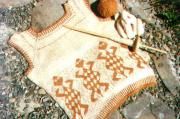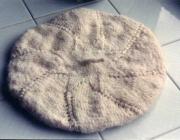Knit a Tube with Circular Needles
Tired of knitting with double pointed needles? Here's a great solution - you can knit small tubes with two circular needles. It's fun and easy!
Knit a Tube with
Circular Needles
This is great for knitting socks, mittens, gloves, or other small tubes when you don't want to use double pointed needles.
This is an ingenious technique that seems to have been discovered by Cat Bordi and Joyce Williams at about the same time. Two circular needles are used to knit a tube. The technique is simple, one half of the tube is worked off the points of one circular needle, and the other half rests on the band of the second, which has just enough bend to give the working needles the angle they need.
While not really faster than knitting with four double pointed needles, this technique is certainly less intimidating to the beginning sock knitter. It is also great for mittens, gloves, and even the top part of hats where the sts are coming together.
I have always liked knitting on double pointed needles, and never found them to be difficult. So, at first I had a hard time with the circular technique. Changing needles is a bit slower with the circular needles because you have to pull the working needle off the sts, slide the new needle into place, grab the back end of the new needle and position it to start knitting again.
At first this was a little frustrating for me, but after awhile my hands seemed to learn the new movements, and my speed increased. After finishing a couple of socks I have to say that, even though each needle change is slower, changes are done only half as many times as with double pointed needles, and it all comes out equal.
There are many other positive points for working tubes with circular needles. What I like best is that my work is so easy to put down, stick in a carry bag, and pick up again. I never have to worry about sts slipping off, or losing that loose needle.
It is very handy to have my sock "palette" divided in two sections for fancy patterns. Because sts are divided in half, the instep sts can be held on one needle, and heel/sole sts on the other.
Last, but not least, it is very easy to try your sock, mitten, or glove on for fit as you go. Simply slip all sts down the bendable cable on the circular needle, and put the sock on your foot. Trying on regularly as you go insures both a proper width to the sock (if you are willing to rip out one that isn't fitting right), and a perfect length for the toe.
So with all that praise for this new way of knitting--Let's get started!!
Cast 36 sts onto one circular needle. Then slip half the sts onto second circular needle, creating a "V". (You are going to join in just a second...when you do, be careful not to twist sts.)
| |
| To create a smooth top edge, join as follows: Slide all your sts down to the other end of the pair of circular needles. Slip first st cast-on from end of first needle to second needle, and then slip last st cast-on from second needle onto the first needle, passing over first st. | |
| 1. Half the sts are on each needle. Slide not-working sts down onto the bendable band. 2. Now grab end of forward needle and work ribbing across. All the sts on working needle are knit with the free end of that same needle. Sts are never transferred to the other needle. 3. Now you just knit happily away, going around and around the tube. At first changing from needle to needle will seem slow to those familiar with double pointed needles. Experience will create speed. I find it best to slide unused needle down just about to the end so it is easier to grab when I make my next turn. |



